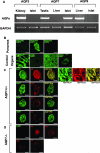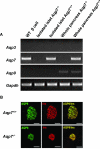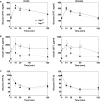Aquaporin 7 is a beta-cell protein and regulator of intraislet glycerol content and glycerol kinase activity, beta-cell mass, and insulin production and secretion
- PMID: 17576812
- PMCID: PMC1952143
- DOI: 10.1128/MCB.00384-07
Aquaporin 7 is a beta-cell protein and regulator of intraislet glycerol content and glycerol kinase activity, beta-cell mass, and insulin production and secretion
Erratum in
- Mol Cell Biol. 2007 Oct;27(20):7354
Abstract
To investigate if intracellular glycerol content plays a role in the regulation of insulin secretion in pancreatic beta cells, we studied the expression of the glycerol channels, or aquaglyceroporins, encoded by the aquaporin 3 (Aqp3), Aqp7, and Aqp9 genes in mouse islets. We found expression of Aqp7 only, not that of Aqp3 or Aqp9, in the endocrine pancreas at both the mRNA (by reverse transcription-PCR) and protein (by immunohistochemistry) levels. Immunohistochemistry revealed a complete overlap between insulin and Aqp7 immunostaining in the pancreatic islet. Inactivation of Aqp7 by gene targeting produced viable and healthy mice. Aqp7-/- mice harbored an increased intraislet glycerol concentration with a concomitant increase of the glycerol kinase transcript level and enzyme activity. The islet triglyceride content in the Aqp7-/- mice was also increased compared to that in the Aqp7+/+ mice. Interestingly, Aqp7-/- mice displayed reduced beta-cell mass and insulin content but increased insulin-1 and insulin-2 mRNAs. The reduction of beta-cell mass in Aqp7-/- mice can be explained at least in part by a reduction in cell proliferation through protein kinase C and the c-myc cascade, with a reduction in the transcript levels of these two genes. Concomitantly, there was a decreased rate of apoptosis, as reflected by terminal deoxynucleotidyltransferase-mediated dUTP-biotin nick end labeling and caspase 3 and Bax expression in Aqp7-/- mice. Compared with Aqp7+/+ islets, islets isolated from Aqp7-/- mice secreted insulin at a higher rate under basal low-glucose conditions and on exposure to a high (450 mg/dl) glucose concentration. Aqp7-/- mice exhibited normal fasting blood glucose levels but elevated blood insulin levels. Their plasma glucose response to an intraperitoneal (i.p.) glucose tolerance test was normal, but their plasma insulin concentrations were higher than those of wild-type mice during the 2-h test. An i.p. insulin tolerance test showed similar plasma glucose lowering in Aqp7-/- and Aqp7+/+ mice, with no evidence of insulin resistance. In conclusion, we found that pancreatic beta cells express AQP7, which appears to be a key regulator of intraislet glycerol content as well as insulin production and secretion.
Figures









Similar articles
-
A new role for aquaporin 7 in insulin secretion.Cell Physiol Biochem. 2012;29(1-2):65-74. doi: 10.1159/000337588. Epub 2012 Mar 1. Cell Physiol Biochem. 2012. PMID: 22415076
-
Metformin inhibits MAPK signaling and rescues pancreatic aquaporin 7 expression to induce insulin secretion in type 2 diabetes mellitus.J Biol Chem. 2021 Aug;297(2):101002. doi: 10.1016/j.jbc.2021.101002. Epub 2021 Jul 22. J Biol Chem. 2021. PMID: 34303707 Free PMC article.
-
Role of aquaporin-7 in the pathophysiological control of fat accumulation in mice.FEBS Lett. 2006 Sep 4;580(20):4771-6. doi: 10.1016/j.febslet.2006.07.080. Epub 2006 Aug 8. FEBS Lett. 2006. PMID: 16919625 Review.
-
Aquaporin-7 and aquaporin-12 modulate the inflammatory phenotype of endocrine pancreatic beta-cells.Arch Biochem Biophys. 2020 Sep 30;691:108481. doi: 10.1016/j.abb.2020.108481. Epub 2020 Jul 28. Arch Biochem Biophys. 2020. PMID: 32735865
-
Metabolic impact of adipose and hepatic glycerol channels aquaporin 7 and aquaporin 9.Nat Clin Pract Endocrinol Metab. 2008 Nov;4(11):627-34. doi: 10.1038/ncpendmet0980. Epub 2008 Oct 14. Nat Clin Pract Endocrinol Metab. 2008. PMID: 18852723 Review.
Cited by
-
The Krüppel-like zinc finger protein Glis3 directly and indirectly activates insulin gene transcription.Nucleic Acids Res. 2009 May;37(8):2529-38. doi: 10.1093/nar/gkp122. Epub 2009 Mar 5. Nucleic Acids Res. 2009. PMID: 19264802 Free PMC article.
-
Aquaglyceroporins in Human Breast Cancer.Cells. 2023 Aug 31;12(17):2185. doi: 10.3390/cells12172185. Cells. 2023. PMID: 37681917 Free PMC article.
-
Aquaporins in Obesity.Adv Exp Med Biol. 2023;1398:289-302. doi: 10.1007/978-981-19-7415-1_20. Adv Exp Med Biol. 2023. PMID: 36717502 Review.
-
Aquaglyceroporins: implications in adipose biology and obesity.Cell Mol Life Sci. 2015 Feb;72(4):759-71. doi: 10.1007/s00018-014-1773-2. Epub 2014 Oct 31. Cell Mol Life Sci. 2015. PMID: 25359234 Free PMC article. Review.
-
Molecular Basis of Aquaporin-7 Permeability Regulation by pH.Cells. 2018 Nov 10;7(11):207. doi: 10.3390/cells7110207. Cells. 2018. PMID: 30423801 Free PMC article.
References
-
- Borgnia, M., S. Nielsen, A. Engel, and P. Agre. 1999. Cellular and molecular biology of the aquaporin water channels. Annu. Rev. Biochem. 68:425-458. - PubMed
-
- Calvo, E. L., N. J. Dusetti, M. B. Cadenas, J. C. Dagorn, and J. L. Iovanna. 1991. Changes in gene expression during pancreatic regeneration: activation of c-myc and H-ras oncogenes in the rat pancreas. Pancreas 6:150-156. - PubMed
Publication types
MeSH terms
Substances
Grants and funding
LinkOut - more resources
Full Text Sources
Medical
Molecular Biology Databases
Research Materials
